Electrolux JBP35, JBP26, JBP24 User Manual

RangesSelf-Cleaning Electric Coil
www.GEAppliances.com
Safety Instructions . . . 2–4
Operating Instructions
Clock and Timer . . . . . . .10
Controls . . . . . . . . . . . . .6, 7
Oven . . . . . . . . . . . . . . . .8, 9
Power Outage . . . . . . . . . .7
Sabbath Feature . . . . .13, 14
Self-Cleaning . . . . . . .15, 16
Special Features . . . . . . . .12
Surface Units . . . . . . . . . . .5
Thermostat . . . . . . . . . . .14
Timed Baking and
Roasting Features . . . . . .11
Care and Cleaning
Broiler Pan and Grid . . . 20
Control Knobs . . . . . . . . .17
Drip Pans . . . . . . . . . . . . .21
Heating Elements . . . . . .17
Lift-Off Oven Door . . . . .19
Lift-Up Cooktop . . . . . . .21
Light . . . . . . . . . . . . . . . . .20
Shelves . . . . . . . . . . . . . . .18
Storage Drawer . . . . . . . .20
Surface Units . . . . . . . . . .21
Vent . . . . . . . . . . . . . . . . .18
Write the model and serial numbers here:
Model # ________________
Serial # ________________
You can find them on a label behind the storage drawer on the front of the range frame.
Troubleshooting |
|
Owner’s Manual |
|
Tips . . . . . . . . . . . . . . |
22–24 |
||
JBP24 |
|||
Accessories |
30 |
||
JBP26 |
|||
|
|
Consumer Support |
JBP35 |
|
Consumer
Support . . . . . . Back Cover
Product
Registration . . . . . . . . 25, 26
Warranty . . . . . . . . . . . . . 31
164D4290P333-1 49-80177-1 07-03 JR
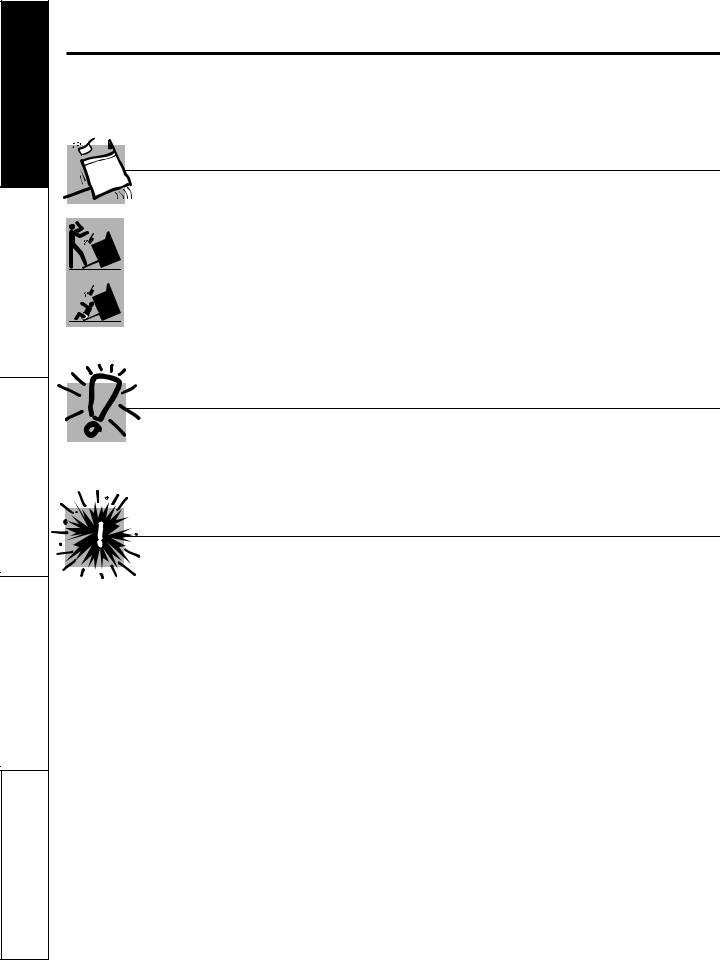
Consumer Support Troubleshooting Tips Care and Cleaning Operating Instructions Safety Instructions
IMPORTANT SAFETY INFORMATION.
READ ALL INSTRUCTIONS BEFORE USING.
 WARNING!
WARNING!
For your safety, the information in this manual must be followed to minimize the risk of fire, electric shock, or to prevent property damage, personal injury, or loss of life.
 WARNING ANTI-TIP DEVICE
WARNING ANTI-TIP DEVICE
All ranges can tip and injury could result.
To prevent accidental tipping of the range, attach it to the wall and floor by installing the Anti-Tip device supplied.
If the Anti-Tip device supplied with the range does not fit this application, use the universal Anti-Tip device WB2X7909.
To check if the device is installed and engaged properly, remove the storage drawer and inspect the rear leveling leg. Make sure it fits securely into the slot.
If you pull the range out from the wall for any reason, make sure the device is properly engaged when you push the range back against the wall. If it is not, there is a possible risk of the range tipping over and causing injury if you or a child stand, sit or lean on an open door.
Please refer to the Anti-Tip device information in this manual. Failure to take this precaution could result in tipping of the range and injury.
IMPORTANT SAFETY NOTICE
The California Safe Drinking Water and Toxic Enforcement Act requires the Governor of California to publish a list of substances known to the state to cause cancer, birth defects or other reproductive harm, and requires businesses to warn customers of potential exposure to such substances.
The fiberglass insulation in self-clean ovens gives off a very small amount of carbon monoxide during the cleaning cycle. Exposure can be minimized by venting with an open window or using a ventilation fan or hood.
 SAFETY PRECAUTIONS
SAFETY PRECAUTIONS
When using electrical appliances, basic safety precautions should be followed, including the following:
■ Use this appliance only for its intended purpose as described in this Owner’s Manual.
■Be sure your appliance is properly installed and grounded by a qualified installer in accordance with the provided installation instructions.
■Have the installer show you the location
of the circuit breaker or fuse. Mark it for easy reference.
■Do not attempt to repair or replace any part of your range unless it is specifically recommended in this manual. All other servicing should be referred to a qualified technician.
■Before performing any service, disconnect the range power supply at the household distribution panel by removing the fuse or switching off the circuit breaker.
■Do not leave children alone—children should not be left alone or unattended in an area where an appliance is in use. They should never be allowed to sit or stand on any part of the appliance.
2■ Do not allow anyone to climb, stand or hang on the door, storage drawer or cooktop. They
could damage the range and even tip it over, causing severe personal injury.
■Large scratches or impacts to glass doors can lead to broken or shattered glass.
■Do not store flammable materials in an oven or near the cooktop.
■CAUTION: Items of interest to children should not be stored in cabinets above a range or on the backsplash of a range—children climbing on the range to reach items could be seriously injured.
■Never wear loose-fitting or hanging garments while using the appliance. Be careful when reaching for items stored over the range. Flammable material could be ignited if brought in contact with hot surface units or heating elements and may cause severe burns.
■Use only dry pot holders—moist or damp pot holders on hot surfaces may result in burns from steam. Do not let pot holders touch hot surface units or heating elements. Do not use a towel or other bulky cloth in place of pot holders.
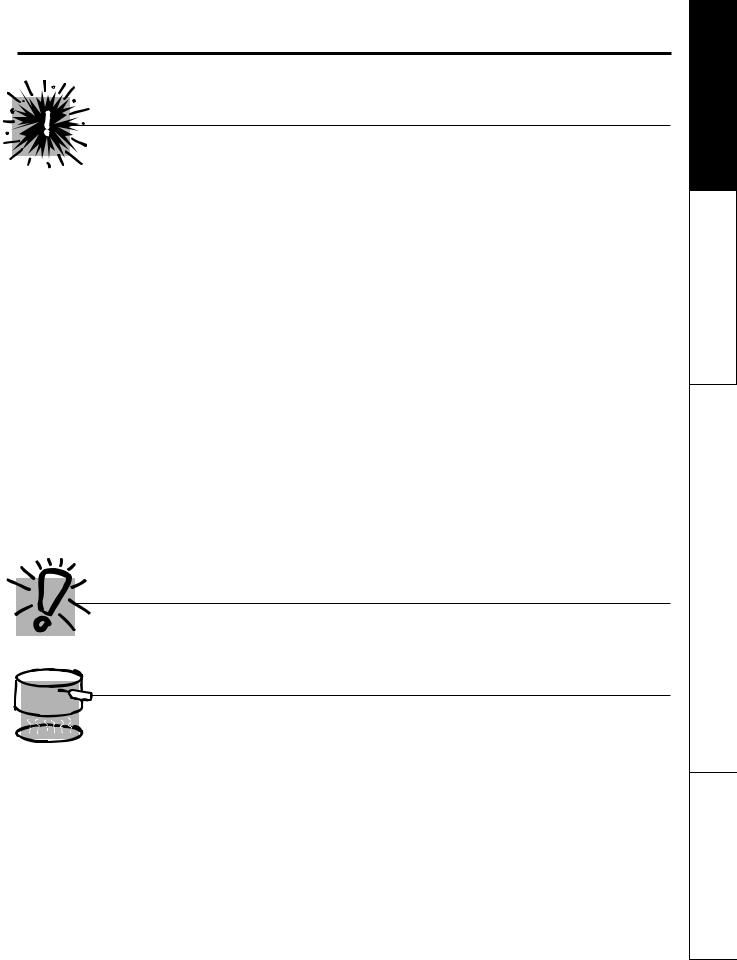
www.GEAppliances.com
 WARNING!
WARNING!
SAFETY PRECAUTIONS
■For your safety, never use your appliance for warming or heating the room.
■Teach children not to play with the controls or any other part of the range.
■Always keep dish towels, dish cloths, pot holders and other linens a safe distance from your range.
■Always keep wooden and plastic utensils and canned food a safe distance from
your range.
■Always keep combustible wall coverings, curtains or drapes a safe distance from your range.
■Do not let cooking grease or other flammable materials accumulate in or near the range.
■Keep the hood and grease filters clean to maintain good venting and to avoid grease fires.
■Do not use water on grease fires. Never pick up a flaming pan. Turn the controls off. Smother a flaming pan on a surface unit by covering the pan completely with a well-fitting lid, cookie sheet or flat tray. Use a multi-purpose dry chemical or foam-type fire extinguisher.
■Flaming grease outside a pan can be put out by covering it with baking soda or, if available, by
using a multi-purpose dry chemical or foamtype fire extinguisher.
■Flame in the oven can be smothered completely by closing the oven door and turning the oven off or by using a multi-purpose dry chemical or foam-type fire extinguisher.
■Do not touch the surface units, the heating elements or the interior surface of the oven. These surfaces may be hot enough to burn even though they are dark in color. During and after use, do not touch, or let clothing or other flammable materials contact the surface units, areas nearby the surface units or any interior area of the oven; allow sufficient time for cooling first.
■Potentially hot surfaces include the cooktop, areas facing the cooktop, oven vent opening, surfaces near the opening, crevices around the oven door.
■REMEMBER: The inside surface of the oven may be hot when the door is opened.
■Do not store or use combustible materials, gasoline or other flammable vapors and liquids in the vicinity of this or any other appliance.
COOK MEAT AND POULTRY THOROUGHLY…
Cook meat and poultry thoroughly—meat to at least an INTERNAL temperature of 160°F and poultry to at least an INTERNAL temperature of 180°F. Cooking to these temperatures usually protects against foodborne illness.
SURFACE COOKING UNITS
Use proper pan size—select cookware having flat bottoms large enough to cover the surface unit heating element. The use of undersized cookware will expose a portion of the surface unit to direct contact and may result in ignition of clothing. Proper relationship of cookware to surface unit will also improve efficiency.
■Never leave the surface units unattended
at high heat settings. Boilovers cause smoking and greasy spillovers that may catch on fire.
■Do not use aluminum foil to line the drip pans or anywhere in the oven except as described in this manual. Misuse could result in a shock, fire hazard or damage to the range.
■Be sure the drip pans and the vent duct are not covered and are in place. Their absence during cooking could damage range parts and wiring.
■Only certain types of glass, glass ⁄ceramic, earthenware or other glazed containers are
suitable for cooktop service; others may break because of the sudden change in temperature.
■To minimize the possibility of burns, ignition of flammable materials and spillage, the handle of a container should be turned toward the center of the range without extending over nearby surface units.
■Always turn the surface units off before removing cookware.
3
Support Consumer Tips Troubleshooting Cleaning and Care Instructions Operating Instructions Safety
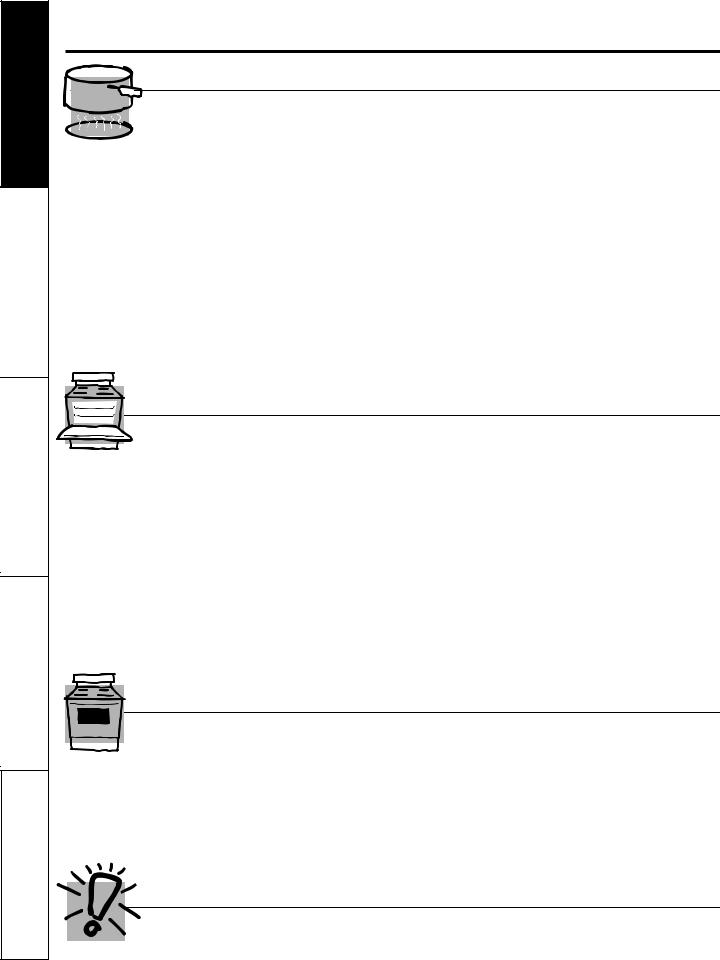
Consumer Support Troubleshooting Tips Care and Cleaning Operating Instructions Safety Instructions
IMPORTANT SAFETY INFORMATION. READ ALL INSTRUCTIONS BEFORE USING.
SURFACE COOKING UNITS (cont.)
■Do not immerse or soak the removable surface units. Do not put them in a dishwasher. Do not self-clean the surface units in the oven.
■When preparing flaming foods under the hood, turn the fan on.
■To avoid the possibility of a burn or electric shock, always be certain that the controls for all surface units are at the OFF position and all coils are cool before attempting to lift or remove
a unit.
■Clean the cooktop with caution. If a wet sponge is used to wipe spills on a hot cooktop, be careful to avoid steam burns.
■Keep an eye on foods being fried at high or medium high heat settings.
■Foods for frying should be as dry as possible. Frost on frozen foods or moisture on fresh foods can cause hot fat to bubble up and over the sides of the pan.
■Use little fat for effective shallow or deep fat frying. Filling the pan too full of fat can cause spillovers when food is added.
■If a combination of oils or fats will be used in frying, stir together before heating, or as fats melt slowly.
■Always heat fat slowly, and watch as it heats.
■Use a deep fat thermometer whenever possible to prevent overheating fat beyond the smoking point.
 WARNING!
WARNING!
OVEN
Stand away from the range when opening the oven door. Hot air or steam which escapes can cause burns to hands, face and/or eyes.
■Do not heat unopened food containers. Pressure could build up and the container could burst, causing an injury.
■Keep the oven vent unobstructed.
■Keep the oven free from grease buildup.
■Place the oven shelf in the desired position while the oven is cool. If shelves must be handled when hot, do not let pot holder contact the heating elements.
■Pulling out the shelf to the stop-lock is a convenience in lifting heavy foods. It is also a precaution against burns from touching hot surfaces of the door or oven walls.
■When using cooking or roasting bags in the oven, follow the manufacturer’s directions.
■Do not use the oven to dry newspapers. If overheated, they can catch on fire.
■Do not use the oven for a storage area. Items stored in an oven can ignite.
■Do not leave paper products, cooking utensils or food in the oven when not in use.
■Do not use aluminum foil to line oven bottoms, except as suggested in this manual. Improper installation of aluminum foil may result in a risk of electric shock or fire.
SELF-CLEANING OVEN
Do not use oven cleaners. No commercial oven cleaner or oven liner protective coating of any kind should be used in or around any part of the oven. Residue from oven cleaners will damage the inside of the oven when the self-clean cycle is used.
■Do not clean the door gasket. The door gasket is essential for a good seal. Care should be taken not to rub, damage or move the gasket.
■Before self-cleaning the oven, remove the broiler pan, grid and other cookware.
■Be sure to wipe up excess spillage before
starting the self-cleaning operation.
■If the self-cleaning mode malfunctions, turn the oven off and disconnect the power supply. Have it serviced by a qualified technician.
■Clean only parts listed in this Owner’s Manual.
READ AND FOLLOW THIS SAFETY INFORMATION CAREFULLY.
SAVE THESE INSTRUCTIONS
4
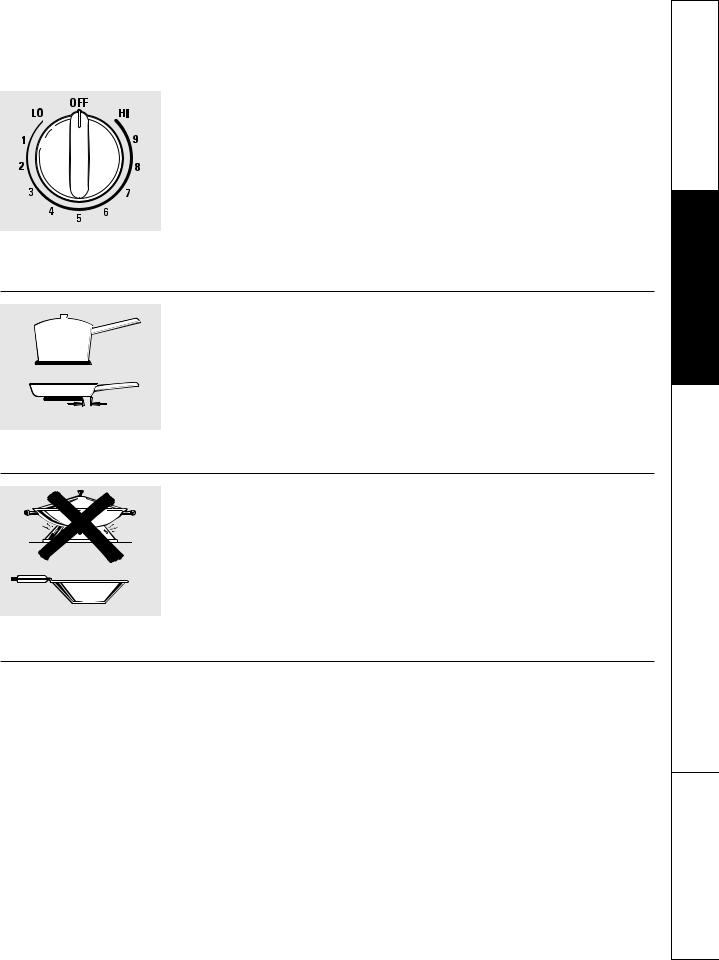
Using the surface units. |
www.GEAppliances.com |
Throughout this manual, features and appearance may vary from your model.
How to Set
Be sure you turn the control knob to OFF when you finish cooking.
Push the knob in and turn in either direction to the setting you want.
At both OFF and HI the control clicks into position. You may hear slight clicking sounds during cooking, indicating the control is maintaining your desired setting.
A surface unit ON indicator light will glow when any surface unit is on.
1″
Not over 1 inch.
Surface Cookware Tips
Use mediumor heavy-weight cookware. Aluminum cookware conducts heat faster than other metals. Cast-iron and coated cast-iron cookware are slow to absorb heat, but generally cook evenly at low to medium heat settings. Steel pans may cook unevenly if not combined with other metals.
For best cooking results, pans should be flat on the bottom. Match the size of the saucepan to the size of the surface unit. The pan should not extend over the edge of the surface unit more than 1″.
Wok Cooking
We recommend that you use only a flat-bottomed wok. They are available at your local retail store.
Do not use woks that have support rings.
Placing the ring over the surface unit will cause a buildup of heat that will damage the porcelain cooktop.
Use only flat-bottomed woks.
Do not use round bottom woks. You could be seriously burned if the wok tipped over.
Home Canning Tips
Be sure the canner is centered over the surface unit.
Make sure the canner is flat on the bottom.
Use recipes and procedures from reputable sources. These are available from manufacturers such as Ball® and Kerr® and the Department of Agriculture Extension Service.
To prevent burns from steam or heat, use caution when canning.
5
Support Consumer Tips Troubleshooting Cleaning and Care Instructions Operating Instructions Safety
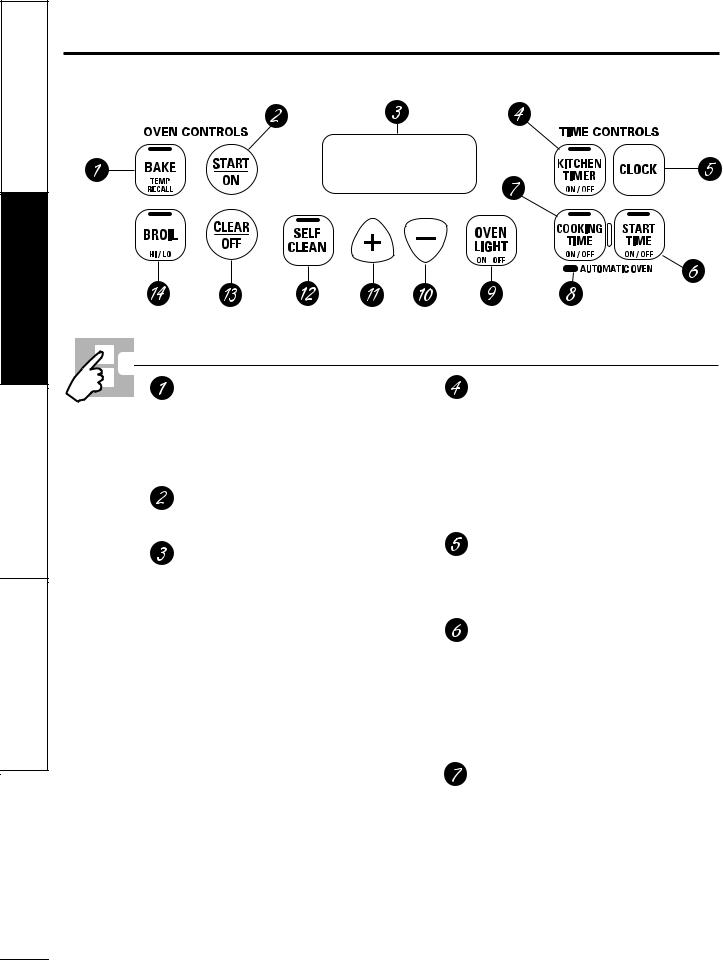
Consumer Support Troubleshooting Tips Care and Cleaning Operating Instructions Safety Instructions
Using the oven controls.
Throughout this manual, features and appearance may vary from your model.
Oven Control, Clock and Timer Features and Settings
BAKE/TEMP RECALL Pad
Touch this pad to select the bake function.
BAKE Light
Flashes while in edit mode—you can change the oven temperature at this point. Glows when the oven is in bake mode.
START/ON Pad
Must be touched to start any cooking or cleaning function.
Display
Shows the time of day, oven temperature, whether the oven is in the bake, broil or self-cleaning mode and the times set for the timer or automatic oven operations. The display will show PRE while preheating. When the oven reaches the selected temperature, the oven control will beep and the display will show the oven temperature.
If “F– and a number or letter” flash in the display and the oven control signals, this indicates a function error code.
If your oven was set for a timed oven operation and
a power outage occurred, the clock and all programmed functions must be reset.
The time of day will flash in the display when there has been a power outage. Reset the clock.
If the function error code appears during the self-cleaning cycle, check the oven door latch. The latch handle may have been moved, even if only slightly, from the latched position. Make sure the latch is moved to the right as far as it will go.
Touch the CLEAR/OFF pad. Allow the oven to cool for one hour. Put the oven back into operation. If the function error code repeats, disconnect the power to the range and call for service.
KITCHEN TIMER ON/OFF or TIMER ON/OFF Pad
Touch this pad to select the timer feature. Then press + and – pads to adjust time.
TIMER Light
Flashes while in edit mode—you can change the set time at this point. Glows when the timer has been activated. Flashes again when the time has run out until the control is reset.
CLOCK Pad
To set the clock, press this pad twice and then press the + and – pads. The time of day will flash in the display when the oven is first turned on.
START TIME Pad
Use along with the COOKING TIME or SELF CLEAN pads to set the oven to start and stop automatically at a time you set.
START TIME Light
Flashes while in edit mode—you can change the start time at this point. Glows when the function has been activated.
COOKING TIME Pad
Touch this pad and then touch the + or – pads to set the amount of time you want your food to cook. The oven will shut off when the cooking time has run out.
COOKING TIME Light
Flashes while in edit mode—you can change the set time at this point. Glows when the function has been activated. Flashes again when the time has run out until the control is reset.
6
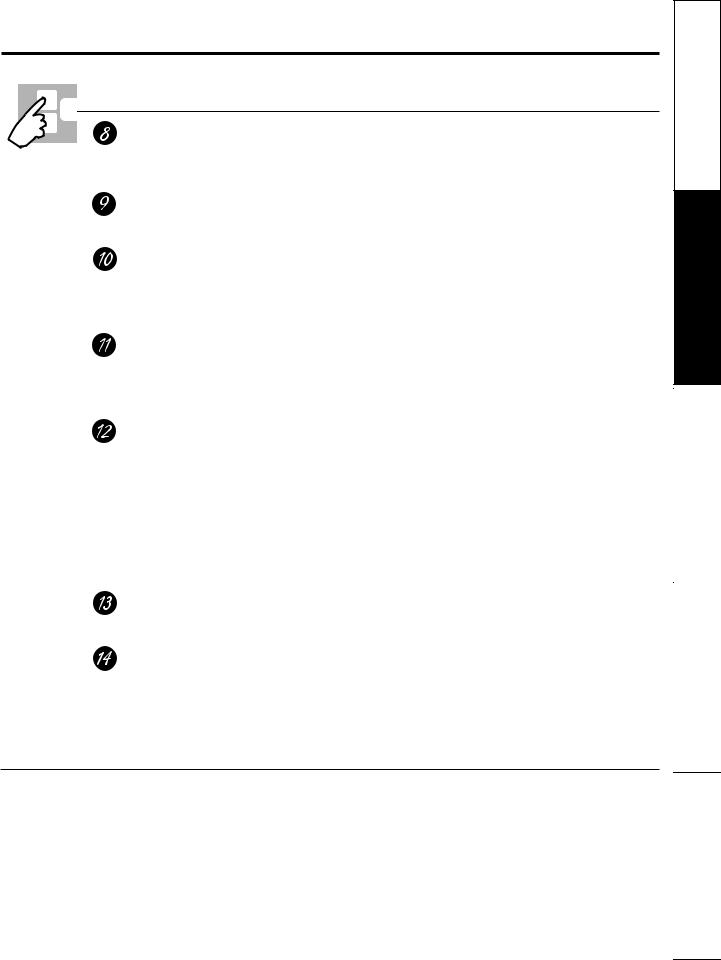
www.GEAppliances.com
Oven Control, Clock and Timer Features and Settings
AUTOMATIC OVEN Light
This lights anytime the oven has been programmed using the COOKING TIME or START TIME functions.
OVEN LIGHT ON/OFF Pad
Touch this pad to turn the oven light on or off.
– Pad
Short taps to this pad will decrease the time or temperature by small amounts. Touch and hold the pad to decrease the time or temperature by larger amounts.
+ Pad
Short taps to this pad will increase the time or temperature by small amounts. Touch and hold the pad to increase the time or temperature by larger amounts.
SELF CLEAN Pad
Touch this pad to select the self-cleaning function. See the Using the self-cleaning oven section.
CLEAN Light
Flashes while in edit mode—you can change the length of time for the self-clean cycle at this point. Glows when the oven is in the selfclean cycle. After the self-clean cycle, the light will turn off. Unlatch the door.
CLEAR/OFF Pad
Touch this pad to cancel ALL oven operations except the clock and timer.
BROIL HI/LO Pad
Touch this pad to select the broil function.
BROIL Light
Flashes while in edit mode—you can switch from HI to LO BROIL at this point. Glows when the oven is in broil mode.
Indicator Lights (on some pads)
EDIT mode lasts several seconds after the last pad press. START TIME ON/OFF and COOKING TIME ON/OFF will be the only pads lit if either of these options is selected. (Example: START TIME is selected with BAKE—the START TIME pad will remain lit until the clock reaches the programmed time, at which point it will turn off and the BAKE/TEMP RECALL pad light will light up).
Power Outage
If a flashing time is in the display, you have experienced a |
To reset the clock, touch the CLOCK pad. Enter |
power failure. Reset the clock. |
the correct time of day by touching the + or – |
|
pads. Touch the START/ON pad. |
7
Support Consumer Tips Troubleshooting Cleaning and Care Instructions Operating Instructions Safety
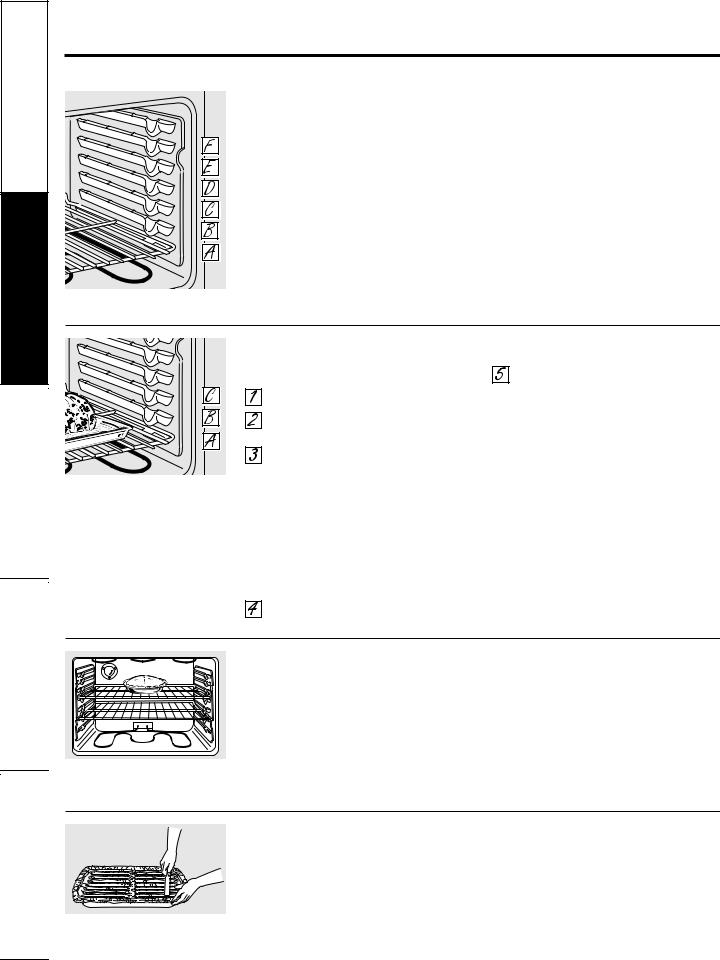
Safety Instructions |
Operating Instructions |
Care and Cleaning |
Troubleshooting Tips |
Consumer Support |
Using the oven.
To avoid possible burns, place the shelves in the desired position before you turn the oven on.
The oven has 6 shelf positions.
Before you begin…
The shelves have stop-locks, so that when placed correctly on the shelf supports (A through F), they will stop before coming completely out, and will not tilt.
When placing and removing cookware, pull the shelf out to the bump on the shelf support.
To remove a shelf, pull it toward you, tilt the front end up and pull it out.
To replace, place the end of the shelf (stop-locks) on the support, tilt up the front and push the shelf in.
CAUTION: When you are using the shelf in the lowest position (A), you will need to use caution when pulling the shelf out. We recommend that you pull the shelf out several inches and then, using two pot holders, pull the shelf out by holding the sides of it. The shelf is low and you could be burned if you place your hand in the middle of the shelf and pull all the way out. Be very careful not to burn your hand on the door when using the shelf in the lowest position (A).
How to Set the Oven for Baking or Roasting
Your oven is not designed for open-door cooking.
Touch the BAKE pad.
Touch the + or – pads until the desired temperature is displayed.
Touch the START/ON pad.
The oven will start automatically. The display will show PRE while preheating. When the oven reaches the selected temperature, the oven control will beep several times and the display will show the oven temperature.
To change the oven temperature during BAKE cycle, touch the BAKE pad and then the + or – pads to get the new temperature.
Check food for doneness at minimum time on recipe. Cook longer if necessary.
Touch the CLEAR/OFF pad when baking is finished and then remove the food from the oven.
Type of Food |
Shelf Position |
Frozen pies (on cookie sheet) |
D |
Angel food cake |
A |
Bundt or pound cakes |
C or D |
Biscuits, muffins, brownies, |
C or D |
cookies, cupcakes, |
|
layer cakes, pies |
|
Casseroles |
C or D |
Turkey |
A |
Center baking pans in the oven.
Preheating and Pan Placement
Preheat the oven if the recipe calls for it. Preheating is necessary for good results when baking cakes, cookies, pastry and breads.
The Display will show “PRE” while preheating. When the oven reaches the selected temperature, the oven control will beep and the display will show the oven temperature.
Baking results will be better if baking pans are centered in the oven as much as possible. If baking with more than one pan, place the pans so each has at least 1 to 11⁄2″ of air space around it. If baking four cake layers at the same time, place two layers on rack B and two layers on rack D. Stagger pans on the rack so one is not directly above the other.
Cut slits in the foil just like the grid.
8
Aluminum Foil
Never cover the oven bottom with aluminum foil.
You can use aluminum foil to line the broiler pan and broiler grid. However, you must mold the foil tightly to the grid and cut slits in it just like the grid.
Aluminum foil may also be used to catch a spillover. To do so, place a small sheet of foil on a lower shelf several inches below the food.
Never entirely cover a shelf with aluminum foil. This will disturb the heat circulation and result in poor baking.
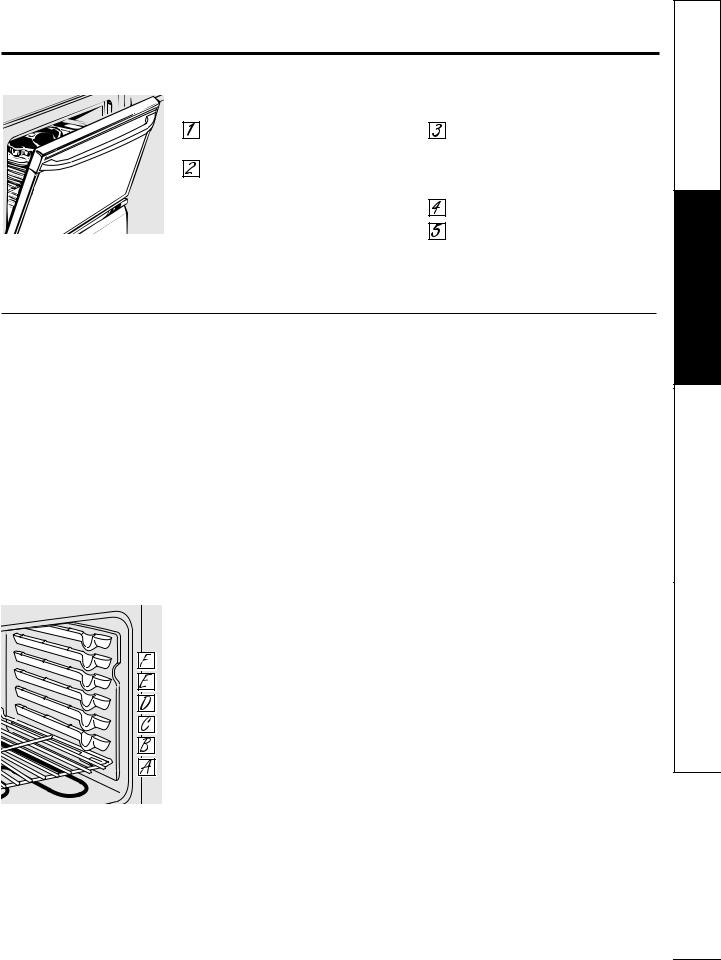
www.GEAppliances.com
Do not latch the oven door during broiling. The latch is used for self-cleaning only.
Leave the door open to the broil stop position. The door stays open by itself, yet the proper temperature is maintained in the oven.
How to Set the Oven for Broiling
Place the meat or fish on the broiler grid in the broiler pan.
Follow suggested shelf positions in the Broiling Guide.
If your range is connected to 208 volts, rare steaks may be broiled by preheating the broiler and positioning the oven shelf one position higher.
Use LO Broil to cook foods such as poultry or thick cuts of meat thoroughly without over-browning them.
Touch the BROIL HI/LO pad once for HI Broil.
To change to LO Broil, touch the
BROIL HI/LO pad again.
Touch the START/ON pad.
When broiling is finished, touch the
CLEAR/OFF pad.
The size, weight, thickness, starting temperature
and your preference of doneness will affect
broiling times. This guide is based on meats at refrigerator temperature.
†The U.S. Department of Agriculture says “Rare beef is popular, but you should know that cooking it to only 140°F means some food poisoning organisms may survive.” (Source: Safe Food Book. Your Kitchen Guide. USDA Rev. June 1985.)
The oven has 6 shelf positions.
Broiling Guide
|
Quantity and/ |
Shelf |
First Side |
Second Side |
|
Food |
or Thickness |
Position* |
Time (min.) |
Time (min.) |
Comments |
|
|
|
|
|
|
Ground Beef |
1 lb. (4 patties) |
D |
13 |
8 |
Space evenly. |
|
1/2 to 3/4″ thick |
|
|
|
|
|
4 lbs. (12 patties) |
D |
15 |
11 |
|
Beef Steaks |
3/4 to 1″ thick |
|
|
|
Steaks less than 3/4″ |
Rare† |
F |
6 |
4 |
||
Medium |
1 to 11/2 lbs. |
E |
8 |
6 |
thick are difficult |
Well Done |
|
E |
10 |
8 |
to cook rare. |
Rare† |
11/2″ thick |
D |
10 |
8 |
Slash fat. |
|
|||||
Medium |
2 to 21/2 lbs. |
D |
15 |
10–12 |
|
Well Done |
|
E |
20 |
20 |
|
Chicken |
1 whole cut up |
C |
25 |
25 |
Brush each side with |
|
2 to 21⁄2 lbs., |
|
|
|
melted butter. |
|
split lengthwise |
|
|
|
Broil skin-side-down |
|
Breast |
C |
25 |
15 |
first. |
Bakery Product |
|
|
|
|
|
Bread (toast) |
2 to 4 slices |
E |
3 |
1 |
Space evenly. Place |
English Muffin |
2 (split) |
F |
3–4 |
|
English muffins cut- |
|
|
|
|
|
side-up and brush |
|
|
|
|
|
with butter if desired. |
Lobster Tails |
2–4 |
C |
18–20 |
Do not |
Cut through back of |
|
|
|
|
turn |
shell. Spread open. |
|
|
|
|
over. |
Brush with melted |
|
|
|
|
|
butter before broiling |
|
|
|
|
|
and after half of |
|
|
|
|
|
broiling time. |
Fish Fillets |
1 lb. (1/4 to 1/2″ thick) |
E |
5 |
5 |
Handle and turn very |
|
|
|
|
|
carefully. Brush with |
|
|
|
|
|
lemon butter before |
|
|
|
|
|
and during cooking, |
|
|
|
|
|
if desired. |
Salmon |
2 (1″ thick) |
|
|
|
|
Steaks |
E |
10 |
5 |
Turn carefully. Do not |
|
Fillets |
2 (1/2″ to 3/4″ thick) |
E |
10 |
|
turn skin side down. |
Ham Slices |
1/2″ thick |
D |
6 |
6 |
|
(precooked) |
1″ thick |
D |
8 |
8 |
|
Pork Chops |
2 (1/2″ thick) |
D |
10 |
10 |
Slash fat. |
Well Done |
2 (1″ thick) about 1 lb. |
D |
15 |
15 |
|
Lamb Chops |
2 (1″ thick) about 10 |
|
|
|
|
Medium |
E |
7 |
4 |
Slash fat. |
|
Well Done |
to 12 oz. |
E |
10 |
9 |
|
Medium |
2 (11/2″ thick) about 1 lb. |
E |
9 |
6 |
|
Well Done |
|
E |
14 |
10 |
|
*See illustration for description of shelf positions. |
|
|
|
9 |
|
Support Consumer Tips Troubleshooting Cleaning and Care Instructions Operating Instructions Safety
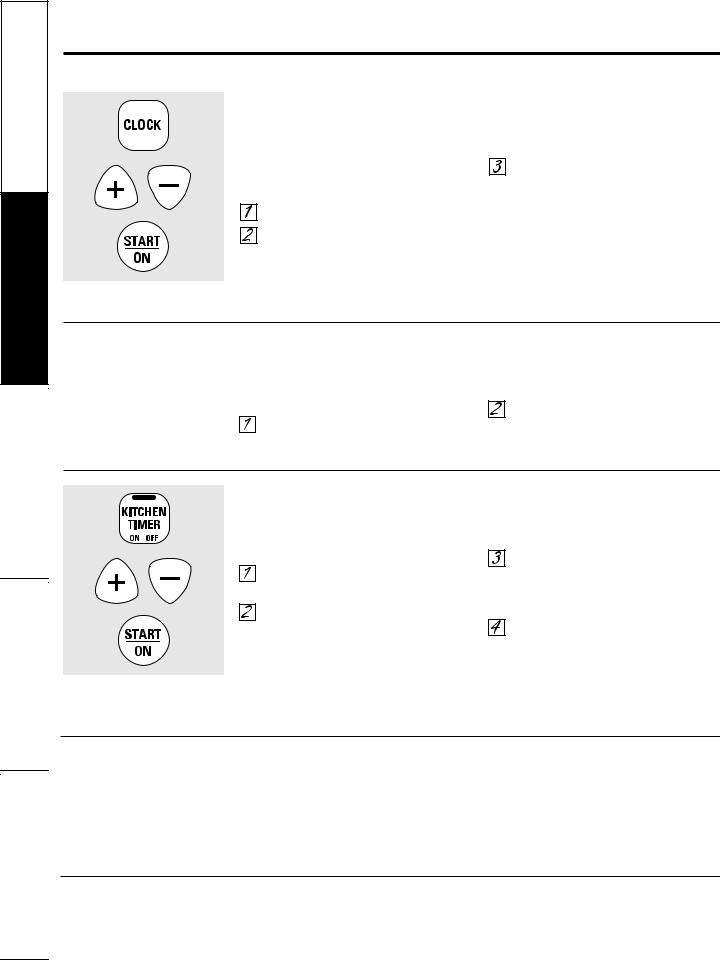
Consumer Support Troubleshooting Tips Care and Cleaning Operating Instructions Safety Instructions
Using the clock and timer.
Not all features are on all models.
Make sure the clock is set to the correct time of day.
To Set the Clock
The clock must be set to the correct time of day for the automatic oven timing functions to work properly. The time of day cannot be changed during a delayed cooking or a delayed self-cleaning cycle.
Touch the CLOCK pad twice.
Touch the + or – pads.
If the + or – pads are not touched within one minute after you touch the CLOCK pad, the display reverts to the original
setting. If this happens, touch the CLOCK pad twice and reenter the time of day.
Touch the START/ON pad until the time of day shows in the display. This enters the time and starts the clock.
To check the time of day when the display is showing other information, simply touch the CLOCK pad. The time of day shows until another pad is touched.
To Turn Off the Clock Display
If you have several clocks in your kitchen, |
clock maintains the correct time |
|
you may wish to turn off the time of day |
of day. |
|
clock display on your range. |
Touch the CLOCK pad twice to recall |
|
Touch the CLOCK pad once to turn |
||
the clock display. |
||
off the time of day display. Although |
|
|
you will not be able to see it, the |
|
The timer is a minute timer only.
The CLEAR/OFF pad does not affect the timer.
To Set the Timer
The timer does not control oven operations. The maximum setting on the timer is 9 hours and 59 minutes.
Touch the KITCHEN TIMER ON/OFF pad.
Touch the + or – pads until the amount of time you want shows in the display. The maximum time that can be entered in minutes is 59. Times more than 59 minutes should be changed to hours and minutes.
If you make a mistake, touch the KITCHEN TIMER ON/OFF pad and begin again.
Touch the START/ON pad. The time will start counting down, although the display does not change until one minute has passed.
When the timer reaches :00, the control will beep 3 times followed by one beep every 6 seconds until the
KITCHEN TIMER ON/OFF pad is touched.
To Reset the Timer
If the display is still showing the time remaining, you may change it by touching the KITCHEN TIMER ON/OFF pad, then touching the + or – pads until the time you want appears in the display.
If the remaining time is not in the display (clock, start time or cooking time are in the display), recall the remaining time by touching the KITCHEN TIMER ON/OFF pad and then touching the + or – pads to enter the new time you want.
To Cancel the Timer
Touch the KITCHEN TIMER ON/OFF pad twice.
10
